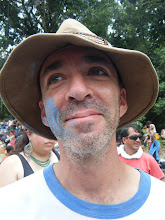View Larger Map
We are now in Borneo. Borneo is the world's largest island and divided into a Malaysian part and a larger Indonesian part. Indonesia Borneo is called Kalimantan. We are primarily in Kalimantan to see orangutans, but we have some distance to cover before we can get to them. Our first meaningful stop is in the city Banjarmasin. We have two activities that we would like to do which is visit floating markets and the traditional diamond mines. Even though to Mika's disappointment we will not be allowed to keep anything that we find.
 |
| The mine |
 |
| The silt and rocks are collected here |
 | ||
| Then filtered out in the large basins in the water to see if they have found anything |
 |
| while others search through the larger rocks looking for a gem |
While watching the process we are approached by young sellers with polished stones wrapped in paper. We have no idea what we are buying, and probably have "sucker" written on our foreheads, but we decide to get some tiny semi-precious stone souvenirs. Mika chooses a purple amethyst and I select a black Kalimantan onyx, or so they say that is what they are. Both for under US $3.00. The miners give us some free unpolished agate that they just found. There is a larger town outside of Cempaka that has a gem polishing center and numerous gem shops. There are also several hotels, so I imagine they get numerous, serious international buyers here.
The other main activity for us in Banjarmasin is to see a floating market where the buying and selling all take place on boats on the river. There are two different floating markets around Banjarmasin. I want to go to the busier one, but different guides give us different information. A guide recommended in the guidebook tells us Kuin Market is the place to go - a shorter boat trip and busiest market. He also tells us that this market dates back 350 years. Since we are not really interested in a guide, just cheap transportation, we end up hiring a goofy guy that has 23 years experience guiding, knows practically nothing and to Mika’s utter disgust, spits when he talks.
The guide picks us up at 5:30 AM and takes us on the river passing rickety wooden homes built over the water. The river is the backyard and the bathroom. At this early AM hour we can see people washing clothes, bathing and brushing their teeth to start their day. The river also serves as the sewer system. I am not exactly sure how clean the water is or if I would want to brush my teeth in a river used as a toilet by my neighbors upstream. But without proper access to running water they have little choice in the matter.
As we pass on the boat it feels slightly invasive. We are uninvited guests observing their personal morning routines. Women bathe wearing sarongs and men are in shorts. I guess I would be too if strangers passed by my open air bathroom every morning.
The small river leads us to a larger river. We begin to see more boats some carrying produce. We arrive to the main area and I am not sure if it is because of misinformation that we received from the “Lonely Planet recommended guide“, or if just the incredibly overcast morning has kept away most of the sellers. Either way the number of boats here is disappointingly small at around twenty-five, not including tourist boats. At the market the sellers paddle around in wood canoes selling produce to the buyers on other boats. Some sellers travel for hours with their wood canoes pulled by a motorized boat from their distant village.
We hang around the market, buy some bananas, have a coffee and donut at the floating café and head back to once again invade the privacy of the bathers, teeth brushers and the laundry washers as we pass their homes on the river. Having our fill of voyeurism we decline our guide’s attempt to sell us his afternoon tour which would take us past many more homes through Banjarmasin’s narrow canal and take a bus to our next destination.
 |
| The Wild Man of Borneo Travel Tip: When searching for a guide in Banjarmasin ask if he will take off his shirt and insist you take photos of him. |



























































